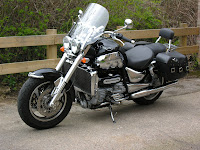Motorcycle Honda CB77
Honda CB77
The Honda Superhawk CB77 is a 305 cc twin-cylinder motorcycle and was produced from 1961 until 1967 (although there are some 1968-registered models). Honda also produced a 247 cc version called the CB72 Dream Sport, while in various advertisements referred to the 305 cc CB77 as a Dream Super Sport. The CB77 is commonly known as the Honda Superhawk (not to be confused with the much later Honda VTR1000F Superhawk), or Honda305.Attributes
~ The motorcycle was known for its robust and precise motor and the overall high quality of fabrication and assembly. The motor was a stressed member of the frame, strengthening the frame and improving the handling over designs with a "dropped-in" motor and cradle frame. All CB models had a forward-arcing kick starter, necessary in order to miss the right-hand footpeg, and re-locatable footpegs that could be sited well rearward (at the expense of forfeiting the pillion) thus enhancing the sporting ride position, especially when the machine was the lo-bar variant.~
 | ||
| Dream Super Sport, Superhawk, Honda 305 cc overhead cam parallel twin kick start, 1961-1967, 28.5 hp (21 kW) |
~The enlarged 305 cc version (60.0 x 54.0 mm) gave 28.5 bhp (21.3 kW) @ 9,000 rpm. The 305 Superhawk proved so agile, powerful (the 1963 CB77 "Super Sport") and well-behaved that it easily outperformed many of its contemporaries with higher displacements. It was capable of 90 mph (140 km/h) without the rider having to lie flat on the tank. Some argue that the advent of the CB77 Superhawk was the beginning of the end to the British bike domination in the field of street and casual race motorcycles. The quality and reliability were far superior. The oil-tight engine, electric-starter and 180-degree crank-throws were also major factors in its success.~
Related bikes
~There is some confusion regarding models imported to the UK - it is known that the CB72 & 77 were called 250 Dream Sport & 300 Dream Super Sport respectively, but where the US Dream models (C, CA, CS & CSA72 & 77) fitted in for UK dealers is unclear, if these models were ever officially imported at all. In the US, the 250 cc CB72 was known as the Hawk, beginning a long line of "hawk" related models that continues today with the CB250 Nighthawk.~
Dream
~The CB72/77 is related to the CA72/77 models as well as to the CL72/77. The Honda C71, C76, C72, C77 Dream and CA72 and CA77 (CA77 is also known as the CA78) were called Dream. Honda Dreams of the 1960s had a similar motor to that on the CB72/77, with the main difference being that the CA72/77 had a pressed frame while CB72/77 had a tube frame with the motor acting as piece of the frame. The motor of the CA72/77 featured a 360 degree crankshaft and single carb. The Honda Dreams were touring bikes with a more relaxed sitting position and more sheetmetal and ornamentation and offered a more docile experience than the blood-stirring Superhawks.~
Scrambler
~Another close Superhawk relative of the era was the Scrambler. Two main versions were produced - CL72 and CL77 - both using the motor essentially identical to that in the CB72/77. The main difference was the gearbox ratios, to allow for the Scrambler's intended use as an off-road bike, and the absence of the electric starter found on the 'road' models - the CL utilised a conventional cradle frame to improve ground clearance and the front downtube passed the motor where the starter needed to be. Although not as capable as a modern off-road bike, the CL72/77 Scrambler did have a high-performance, 9,000 rpm dual-carburated motor, with a very wide power band, high-clearance exhaust pipes and knobby tires.~
~Today this Honda triumvirate, CB72/77 Superhawk, CA72/77 Dream, and CL72/77 Scrambler, enjoys a wide following of bike collectors and restorers.~
Variants
Police
~Honda produced a limited number of the CB77-based Superhawk Full Dress Police bikes, designated CYP77. Most were sold in Asia, although a few examples ended up in other parts of the world. Confirmed original examples are known in Norway, England, Canada and the U.S. The CYP77 bikes were outfitted with a solo seat, a rack with a ticket box, front and rear crash bars, a speed trap speedometer (the officer could fix the highest speed reached in his speedometer, while giving chase) and a cable driven mechanical siren, that reportedly sounds like the police sirens from the 1930s gangster movies.~
CP77 Superhawk
~In most cases, the CP77 Superhawk is essentially a completely stock CB77, however, some believe that the CP77 was intended as a "special options" platform bike for export to different non-US markets. Known and confirmed CP77 examples exist with various options not generally seen in regular production bikes, such as turn signals. Most of the known CP77 bikes are in Canada, although they do turn up in other countries. The CP77 model is equipped with turn signals as the Canadian law required them in the 60’s as the US models did not due to their laws. CP77 also came with high rises bars, non-hinged front foot rest. The CB77 came with flat and low rise bars. The front foot rest in the US were also hinged. CP77 kept the early type taillight only. In the US for the first year models they used the same light, then changed the light as the models progressed.~
CYB77 Superhawk Road Racer
~In the early 1960s, Honda Motor Company entered road race variants of the 250cc and 305cc Superhawk in various European road races with some success. HMC made many of the roadracer parts available in its CB72/CB77 parts manual as factory parts using the part number prefix CYB77. The road racer had megaphone exhausts, clip on handlebars, special roadracing seat, shortened fenders, rear peg gear shift and brake linkages, a telescopic damper for the forks, plus numerous other part options which could be ordered from Honda.~


